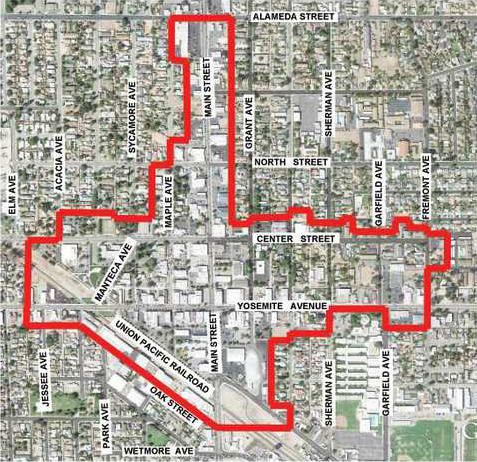Downtown is growing.
A new business and property owners group is working on crafting a vision for downtown Manteca.
And one of the group’s first tasks is to define what constitutes downtown.
The Manteca Downtown Business Association executive board did just that Thursday breaking a nearly century-old downtown definition that encompassed essentially just a dozen blocks straddling Yosemite Avenue and Center Street.
The group’s downtown boundaries go as far north as Alameda Street on Main Street, just beyond Jessie Avenue to the west and to Fremont Avenue on the east.
“Our community has grown in size,” noted Ben Cantu who serves as the administrative coordinator for the Manteca DBA. The “Downtown’s core definition has to grow too.”
Establishing boundaries is a major step given that coming up with any type of strategy to draw more people downtown and to pursue common goals when it comes to things such as overall themes and traffic flow requires first to define the area that is being targeted.
Since 1971, the “official” city designation of downtown was a narrow eight-block area included in the Assembly Bill 121 parking assessment district put in place to develop public parking lots. Downtown interests, by default, allowed that to shape off and on discussions over the years as to what needs to be done to keep the central district on a competitive footing with new retail developments being built on the community’s peripherals.
Cantu noted that the smaller footprint also made it hard to hammer out even a vision for traffic that they could work with city leaders to implement.
“The traffic problems downtown really start at Alameda Street,” Cantu noted.
The definition also knocks the conventional wisdom that downtown’s commerce is essentially along Yosemite and Center as well as streets connecting the two thoroughfares. The Manteca DBA boundaries arguably put more weight on Main Street as well as additional areas such as the 200 block of North Maple Avenue that could ultimately be transformed from residential to retail uses over time.
Defining downtown – and marketing the boundaries – can also go a long way to bring the center of the city into a common focus.
“What downtown is can often be defined where you live in the community,” Cantu said. “If you live south of the 120 Bypass, Walmart can be part of downtown (from your perspective).”
A survey conducted by the consultant the city hired for downtown traffic planning seven years ago underscores Cantu’s point.
He told the council at the time that a phone survey his firm did found out that 90 percent of the people who travel Main Street did so to access a point downtown. That startled city leaders until a follow up was done that showed once you asked people specifically what downtown meant to them you’d get answers as varied as from Walmart to Kmart and shorter segments in between as well as the age-old definition of downtown held by city bureaucrats and some longtime merchants and property owners.
Even the Manteca DBA executive board reflects an expanded footprint in the central district business community. The board consists of two property owners and two business owners and one member at-large. Property owner Marvin Brocchini – who owns the American Furniture building at 127 E. Yosemite Ave. - is within the traditional downtown area. The other property owner –Crystal Downs of State Farm Insurance at 259 N. Main St – is part of the North Main corridor that the Manteca DBA has included in its downtown footprint.
Member-at-large Suzanne Candini is within the expanded boundaries along East Center Street where she operates Manzanita Ventures out of a converted home at 204 N. Sherman Ave.
The two business owners – Ron Van Essen of Financial Network at 129 E. Center St. and Peter Oropeza of Super Altena Market at 223 E. Yosemite – are part of the original area.
All five members are faces that have been associated with previous efforts that have essentially ended up going nowhere to forge a downtown-based advocacy group whose objective is to develop a vision for downtown in a bid to increase business.
“Downtown is no different than a shopping complex such as Orchard Valley,” Cantu said.
By that, he means they have to compete for retail and measure dollars just like any other shopping area.
It has taken close to a year to get to the point the Manteca DBA is at today. It has been forged out of spirited disagreements that have historically orbited around downtown politics.
“It can be frustrating because it has taken a long time,” Cantu said.
But given the fact the fledgling organization has agreed on boundaries dictated not by political decisions by City Hall but from within the nucleus of property owners and businesses in the central district is a major step. In the past 10 years, two attempts were made to complete that exercise but each one ultimately fizzled for various reasons.
The Manteca DBA has already presented letters of introduction to the Manteca City Council and local chamber of commerce organizations such as the Manteca Chamber of Commerce and the Central Valley Hispanic Chamber of Commerce.
Cantu said the next step for the group is to work on a common vision for the expanded downtown footprint.
Downtown Manteca grows in size
Advocacy group redefines downtown boundaries





